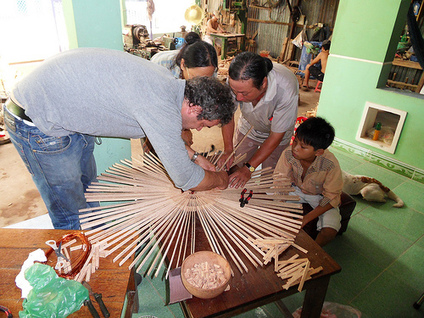Support fair trade all year long
October is Fair Trade Month, but let’s talk about how fair-trade good contribute to your own and others’ happiness. Everyone from Ben & Jerry’s (buy one, get one fair trade ice cream all month!) to your neighborhood boutique is talking fair trade—here’s the who-what-why (out of order).
WHY Fair Trade
“Historically, the term ‘fair trade’ has meant many things. The Fair Trade League was founded in Britain in 1881 to restrict imports from foreign countries. In the United States, businesses and labor unions use ‘fair trade’ laws to construct what economist Joseph Stiglitz calls ‘barbed-wire barriers to imports,’” says Robert Skidelsky, Professor Emeritus of Political Economy at Warwick University. But the fair trade of today started emerging in the ’80s with an increased focus on trading goods and commodities from smaller producers, often in poor countries.
According to World Bank research, since the 1970s, commodity prices have fallen in international markets at the same time that consumer prices have risen. The asymmetric response, which has been attributed to trade restrictions and rising processing costs, appears to be caused largely by the behavior of international trading companies. Many of these companies are large enough to dominate most commodity markets.
So, while the standard trade model favors large plantations, agri-business, and multi-national corporations, fair trade supports small farmers and producers. Non-profits and religious organizations are often included in this umbrella because they work with artisans and producers coming out of dire situations like slavery, human trafficking, or poverty. Happiness point number one: people leaving desperate situations get happier.
WHAT Fair Trade
First, know that Fair Trade Month was created by Fair Trade USA, an organization that is embroiled in controversy amidst claims from other fair trade groups (like Equal Exchange, who posted an open letter) for abandoning global fair trade organizations and relaxing restrictions.
Coffee, tea, cocoa, herbs, spices, cotton, produce, and sugar are some of the most common fair-trade items, along with artisanal goods like jewelry, home goods, and clothing and accessories. Often, but not exclusively, non-profits help elevate groups of people out of slavery, himan trafficking, or poverty through the production of fair-trade artisan goods. Happiness point number two: just changing where you buy goods you already buy can help support other people.
WHO Fair Trade
Fair trade groups and re-sellers help facilitate higher market prices for providers, the provision of credit, enforcement of labor standards, and external monitoring of these policies. Alongside the ones mentioned previously, we’ve found some good websites for information, directories, and more. For bricks-and-mortar stores and online shopping, click over to Ten Thousand Villages. To search for stores near you or online sites, try Fair Trade Federation’s listings. And for some of our fave fair-trade goodies, check out our own Good Shopping: 9 Fine Fair Trade Organizations, which focuses exclusively on artisanal goods. Happiness point number three: it’s easy to shop fair trade, so get to it!
Image: Some rights reserved by changemaker2011

